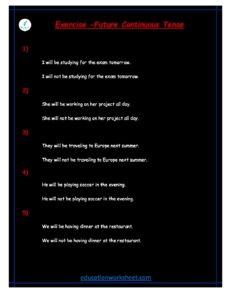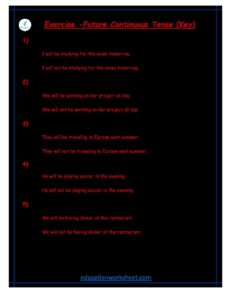changing Future Continuous Tense to negative and positive
changing Future Continuous Tense to negative and positive
Tenses play a pivotal role in the English language, enabling us to convey actions, events, and states in various time frames. One such tense that serves a unique purpose is the Future Continuous Tense. This tense is essential for expressing actions that will be ongoing at a specified point in the future. In this comprehensive guide, we will explore how to construct both positive and negative sentences in the Future Continuous Tense, consisting of detailed explanations, examples, and practical tips.
Constructing Positive Sentences in Future Continuous Tense

To form a positive sentence in the Future Continuous Tense, you need to use the base form of the verb ‘to be’ (will be) and add the present participle (the base form of the main verb + -ing). The structure is as follows:
[Subject] + will be + [base form of the verb] + -ing
Let’s break down each component:
- Subject: The subject is the person, thing, or entity performing the action. It can be a noun, pronoun, or even a proper noun (specific name). Examples include “I,” “he,” “she,” “they,” “John,” “the cat,” and so on.
- Will be: This is the auxiliary verb that indicates the future tense. It remains constant in all positive Future Continuous sentences.
- Base form of the verb: This is the primary action verb. It is usually the infinitive form of the verb (e.g., “eat,” “run,” “study”).
- -ing: To create the continuous aspect, add -ing to the base form of the main verb.
Let’s consider some examples:
- I will be working at the office tomorrow.
- Subject: I
- Auxiliary Verb: will be
- Base Form of the Verb: work
- Continuous Aspect: working
- Meaning: The speaker (I) will be engaged in work at the office in the future.
- They will be watching a movie tonight.
- Subject: They
- Auxiliary Verb: will be
- Base Form of the Verb: watch
- Continuous Aspect: watching
- Meaning: The group (They) will be actively viewing a movie later in the evening.
- She will be running in the park at 6:00 AM.
- Subject: She
- Auxiliary Verb: will be
- Base Form of the Verb: run
- Continuous Aspect: running
- Meaning: She will be involved in running in the park at 6:00 AM.
Constructing Negative Sentences in Future Continuous Tense

Creating negative sentences in the Future Continuous Tense involves adding ‘not’ after the auxiliary verb ‘will.’ The structure for negative sentences is as follows:
[Subject] + will not (won’t) + [base form of the verb] + -ing
Let’s explore the components in detail:
- Subject: Just as in positive sentences, the subject refers to the entity carrying out the action. It can be any noun, pronoun, or proper noun.
- Will not (won’t): In negative sentences, ‘will not’ is contracted to ‘won’t’ for smoother and more casual conversation. It signifies the future tense and negates the action.
- Base form of the verb: This remains unchanged from the positive construction, representing the core action verb.
- -ing: The continuous aspect is maintained by adding -ing to the base form of the main verb.
Now, let’s illustrate negative Future Continuous sentences:
- I won’t be working late tonight.
- Subject: I
- Auxiliary Verb: won’t
- Base Form of the Verb: work
- Continuous Aspect: working
- Meaning: The speaker (I) will not be working late tonight.
- They won’t be traveling during the holidays.
- Subject: They
- Auxiliary Verb: won’t
- Base Form of the Verb: travel
- Continuous Aspect: traveling
- Meaning: The group (They) will not be traveling during the holidays.
- She won’t be studying at the library tomorrow.
- Subject: She
- Auxiliary Verb: won’t
- Base Form of the Verb: study
- Continuous Aspect: studying
- Meaning: She will not be studying at the library tomorrow.
Practical Tips for Using Future Continuous Tense

- Clarity: Ensure that your sentence is clear and conveys the intended meaning. Specify the time or circumstances when the action will be happening in the future. For example, “I will be cooking dinner” is less informative than “I will be cooking dinner at 7 PM.”
- Use of Contractions: In casual conversation or writing, contractions like “won’t” for “will not” can be used for a more natural flow. However, in formal writing, it’s advisable to use the full form.
- Interrogative Sentences: To form questions in the Future Continuous Tense, invert the subject and the auxiliary verb “will,” and add the base form of the verb + -ing. For example, “Will they be traveling tomorrow?”
- Negative Questions: For negative interrogative sentences, follow the same inversion rules, and include “not” after “will.” For instance, “Won’t she be attending the meeting?”
- Practice: Practice is the key to mastering any grammatical structure. Try constructing both positive and negative Future Continuous sentences on various topics to become more comfortable with this tense.

